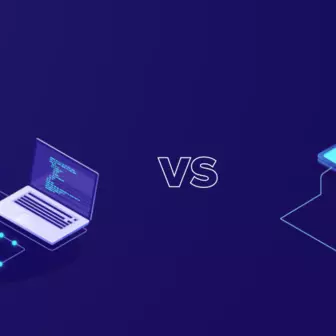Cloud computing has brought the hidden revolution in the IT industry by shifting people from traditional local storage and processing to network-based services. Additionally, the reliable internet connection has assembled a lot many opportunities by leveraging effective distant communication among computers. Contrastly, with cloud computing, the thought process of computers has enhanced.

Moving ahead, artificial intelligence (AI) and machine learning (ML) are spreading their wings in every industrial domain ranging from healthcare to travel & tourism to technology. AI is transforming them all with its definite pace and in a planned strategic approach. When coupling cloud computing with AI and machine learning, the extensibility, procurement, and resilience offered by a cloud infrastructure make it an ideal choice for building an AI/ML pipeline.
However, when it comes to the data preparation and pipelining in the cloud, it brings several challenges alongside which needs to be resolved for an effective AI/ML pipeline building in the cloud.
Let’s look into the subject and find out where an AI, ML and cloud association leads us to.
Artificial Intelligence & Machine Learning in Cloud - ‘Decoded’
Digital transformation has brought the world closer than ever driving smooth operations in an enterprise. Machine learning is succeeding in the digital transformation discussions from the past few years. Organizations are working headlong to cater to a system wherein the processes are streamlined with no human intervention. Machine learning and artificial intelligence, when connected with the cloud, will bring benefits for the system as a whole.
When talking about cloud computing we have come too far from storing data in floppies, USBs, hard-drives to managing, processing, and scaling-up the data for the large enterprise applications. The elasticity, on-call availability, upscale effectiveness and improved IT abilities are a driving force for the companies to be on-cloud. Also, providing a competitive edge to the organizations in total. The amalgamation of cloud computing, AI and machine learning, accelerates organizations' objectives achievement at a much faster pace. When combined together, the former mentioned is far better than curling through the many manual algorithms. However, nothing comes easy and the same is with the AI/ML pipelines implementation, the challenges associated has been articulated ahead.
Challenges that follow while implementing AI/ML Pipeline on Cloud
For the successful AI/ML data analysis, data is a crucial factor. Therefore, data preparation is antecedent when instrumenting an AI/ML pipeline. Data preparation and pipelining exhibits the following challenges.
- Handling data manually: It has been seen that data is prepared through manual script-writing in R or Python by the data scientists. This makes the process tedious and time-consuming for the data scientists. Along with it, utmost care is to be taken on data or code creation as manual data handling brings many uncalled errors.
- Choose one: Exercising an AI and ML data preparation, a massive amount of data and time is needed. When working on or improving the AI/ML pipelines companies are made to do the selection in-between time, money or accuracy confronting into a no-escape dilemma.
- Troubled data reusability & reproducibility: The manual data preparation by the scientists makes it a little difficult to retrieve and reuse data assets, namely, data models and pipelines. The reason being the straightening done by the data scientists to incur changes in the code. Consequently, proper documentation for the data is recommended for pragmatic data alignment as per the organization's guidelines and regulations. Furthermore, any transition made in the data should be noted step by step keeping it aligned with data privacy laws, like GDPR(General Data Protection Regulation), etc.
- Reimplementation: The creation of a new data model is followed by giving it forth to the operations team, which does the reimplementation of the data model to use it extensively. The process of reimplementation is a bit clumsy with the involvement of various groups eventually leading to a lot many errors, confusion, longer implementation times and tiresome execution models.
Resolving the associated challenges
This section consists of the bullet points indicating solutions for the challenges related to AI/ML pipeline in the cloud.
- Data preparation with agile in data pivot impressions instead of manual data preparation: Data is prepared through simple, data-centric figures with the data preparation and pipelining platforms. This promotes easy exploration of data from innumerable numbers of records with numerous attributes without losing the explorer into an infinite loop.
- Implementing data merge instead of reusability and reproducibility: Data is collected in the form of metadata by data preparation and pipelining platforms. This allows the logging of the changes in the form of reports like moving, combining or applying algorithms, etc. These reports are easily accessible by those having the permit. Reversing and changing the algorithmic function will do the revision of metadata which will be reflected automatically.
- Operationalize instead of reimplementing: Operationalization has a tangible and measurable impact on the application and development environment. It brings clarity by initiating the process in one platform, additionally tracking of the changes gets streamlined with the intact security measures.
Use cases: AI and ML pipelines instrumentation in the Cloud
Google Cloud AI and TensorFlow TFX pipelines association
Extensible and high-performance machine learning functions are executed with TFX pipelines. The TFX constituents assist in modeling, training, serving, and deployment management to online, native mobile, and JavaScript targets. Moreover, the TFX platform deals with numerous crucial deployment challenges which can be like viewing model performance in various data pieces, quality checks, and input data validation, to name a few.
Following advocates how the association of Google Cloud and TFX platform can be used for individual ML applications.
- Serverless autoscaling execution engine ‘Cloud Dataflow’ for Apache Beam based components:
Developed for distributed processing, Apache Beam runs natively on Google Cloud with Cloud dataflow. It offers a smooth automatic scaling duration, giving access to a huge amount of on-demand computing capability. When running beams on Cloud dataflow allows access to extensive features like Dataflow shuffle etc. Consequently, Apache beam comes with a capability to run on numerous other execution environments comprising Apache Flink for both on-prem and multi-cloud environment.
- Streamlined development, deployment, and management of TFX workflows with Kubeflow pipelines
Escalated through the Kubeflow open source project, Kubeflow pipelines facilitates development, deployment, and management of TFX workflows on Google Cloud. The process is carried with Google Kubernetes Engine (GKE), via the 1-click deploy which does the automatic configuration, operates essential backend services. GKE provides security and accessibility maintenance alongside tooling, monitoring and generating metrics.
Additionally, Cloud ML engine offering distributed model training and scalable model serving, Cloud Dataflow driving scaled TFX component execution and workflow and Kubeflow Pipelines on GKE (Google Kubernetes Engine) promoting metadata orchestration and simplified management and scaled the TFX workflow execution.
AI Hub for Simplified AI deployment
Conceived by Google, AI Hub broadens the AI arena inside the businesses by simplifying identification, sharing and reuse of existing tools for further work. Jupyter notebooks, and TensorFlow modules employes AI Hub for ML content, delegating following major benefits:
- Businesses can use publicly available qualitative Ml resources developed by Google Cloud AI, Google Research and other teams across Google.
- A secure, private hub is offered by Google to share ML resources within the organization. It channelized pipelines reuse and their deployment into the production in GCP (Google Cloud Platform) or on other hybrid infrastructures with the Kubeflow pipeline system.
Conclusion
Data creation, analysis, and management have been a major lately. Composition and channelization of data is a time-consuming task whether we talk in a cloud-based scenario or on an on-premise. An excessive amount of time gets wasted when data analysts start working on basic activities. It will do no benefit to the companies if they will keep their best data scientists focused on such low lying activities.
In addition to that, reusability, reproducibility will be a cost-ineffective for the companies when data moved to and from the cloud. In order to be on an advantageous side, it is imperative for organizations to build a persistent platform for data preparation and pipelining like blending data in the form of metadata, imposing operational activities, etc. This simplifies the process and makes it fast keeping the no-access to the unauthorized. AI Hub, Kubeflow are the few implementations that have been seen in Google Cloud.
Subscribe
Related Blogs
Serverless vs Managed Services: Which One to Choose

When you decide to build an application in the cloud, you need to consider several factors. One of the most important…

Over the past few years, the cloud industry has gone through an extreme change with the transformation of serverless…
Putting The Serverless Trend Under a Microscope

Flexible. Scalable. Economical. These terms essentially sum up the advantages of serverless computing, an architecture that…



